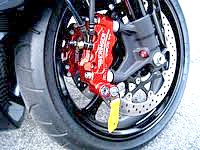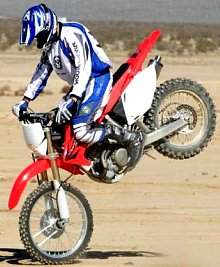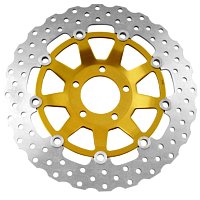Sign up today to get your FREE newsletter and BONUS info!
How to Select and
Maintain Your Motorcycle Disc Brakes...and Other Stuff You Need For Stopping
Your motorcycle disc brakes -- as I'm sure you know -- are part of one of you bike's most vital systems.
Without a properly functioning brake system, you can't operate your motorcycle safely or efficiently.
Here's info to help you to…
- Maintain your bike's brakes...
- Select replacement brake system components...
- Do a bit of brake system customizing
Click here for a great place to find motorcycle brake pads, discs
and other cycle parts and accessories for all situations…
Motorcycle disc brake systems that you see on most motorcycles today rely on these four primary components…
- Brake pads
- Rotors -- also called discs or disks
- Calipers
- Hydraulic brake fluid lines
Here's how a motorcycle disc brake system works…
Disc brakes stop your motorcycle when the brake pads -- held loosely in position by the calipers -- grip each side of the steel rotors attached to your bike's wheels.
Each caliper contains four or six hydraulic pistons that press the brake pads forcefully against a rotor's sides to slow or completely stop its rotation, which stops your motorcycle.
Most motorcycles have two rotors on the front wheel and one on the rear.
Modern motorcycle disc brake systems require very little maintenance, but it's important to periodically check and possibly replace or repair individual components.
And when replacing components, use your motorcycle's original equipment as a baseline reference. Then look for the same or other components that meet your performance and price requirements.
Here's info to help you maintain or repair your motorcycle's disc brake system...
Periodically check to make sure your motorcycle's brake pads are within spec and thick enough to stop your motorcycle properly.
Pads contain a groove or "wear bars" to let you know when they're worn excessively thin. Past that point, they won't give you sufficient stopping power, or they could burn or gouge your rotors.
If your motorcycle brake pads are worn way down and out of spec, replacing them is a basic maintenance procedure.
You have these two types of replacement brake pads to choose from…
- Organic
- Sintered
Organic pads are made of bonded fibers such as Kevlar.
Sintered metal pads are made of copper alloys fused together with heat and pressure to give you great stopping power and long wear.
You'll find sintered brakes on the vast majority of new motorcycles. They're the brake material of choice for most aftermarket motorcycle brake pads.
For racing motorcycles, sintered brakes last the longest. They handle heavy braking and heavy heat better than organic pads.
However, when it comes to cruising and touring, you'll find that high quality organic brake pads perform on a par with sintered motorcycle brakes.
Plus, some riders prefer the feel and feedback of organic pads over sintered.
You might want to try a few brands to determine -- over time -- what works best for you and your motorcycle.
- Brake fluid lines
Look for hydraulic fluid leaks. If you can't remedy a brake line leak by simply tightening a fitting, then replace the faulty brake line section.
- Calipers

Look for fluid leaks. If you see fluid oozing or dripping from a brake, have your motorcycle mechanic rebuild the caliper. The repair process is not a big deal, but it must be done right.
You can also look into upgrading your motorcycle's stock calipers rather than making straight-forward repairs.
Motorcycle disc brake systems and individual components are constantly improving. So if your bike is a few years old, perhaps you can take advantage of new brake caliper technology.
That is, of course, if the price of new calipers falls within your budget.
Check each rotor for excessive wear due to routine, long-term use.
Measure each rotor's thickness with a micrometer or ask your mechanic to do the measuring. You can find a rotor's minimum safe thickness engraved into its side.
Also check the rotors for scoring or gouges or other damage caused by excessively thin pads or by sand and dirt trapped under the pads.
Replace rotors that are out of spec or are warped, scored or otherwise damaged.
Use your bike's original equipment specs to set a baseline for the appropriate size and shape for replacement rotors.
You'll find that individual rotors are made for either right-hand-side or left-hand-side installation on your motorcycle's front or rear wheel.
You can find rotors in different shapes and colors if you're looking to customize your motorcycle. They also come in different diameters. Larger diameter rotors can dissipate heat most efficiently because of their increased surface area.
"Floating rotors" have a two-piece design consisting of an interior ring attached to an exterior -- friction -- ring.
This configuration uses slotted holes to hold the fasteners that attach the interior ring to the friction ring. The slots enable the friction ring to expand and contract separately from the interior ring. This reduces the likelihood that the friction ring will warp due to the intense heat generated during braking.
Unfortunately, replacing your motorcycle disc brake system's rotors is time consuming and expensive -- even if you do the job yourself.
However, unless the rotors are damaged, your rotors should last tens of thousands of miles before replacement is necessary
- Brake fluid
Whenever you work on your brakes -- especially the brake lines or calipers -- and there's the possibility that air entered the brake system, be sure to bleed the brake lines and pump out any air bubbles that formed in the fluid.
Be sure to top up the fluid to replace any pumped out during bleeding.
Also, it is a good idea to bleed your bikes hydraulic brake system annually to get rid of the old brake fluid -- which can attract and hold moisture -- and replace it with new, clean fluid.
And please make sure you don't drip any fluid onto your motorcycle -- especially onto a painted surface. The stuff really eats into paint and metal.
Click here for a great place to find motorcycle brake pads, discs
and other cycle parts and accessories for all situations…
Return from Motorcycle Brakes to the main
Let's stay in touch!
Get your free subscription to..."Savvy Motorcyclist E-zine"
And you'll also receive your free copies of...“The 10 Best Motorcycle Travel and Trip Planning Websites on the Internet” ... plus the Motorcycle Safety Foundation’s 58-page Motorcycle Operator’s Manual.
These great resources will help you to ride better, plan your trips, enjoy the best motorcycle roads and get the most out of motorcycle riding.



